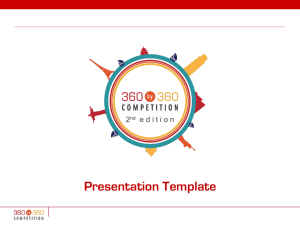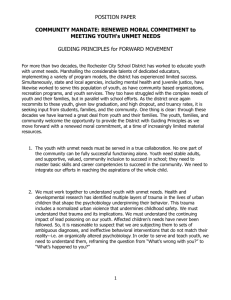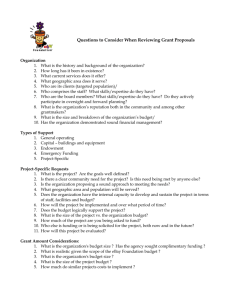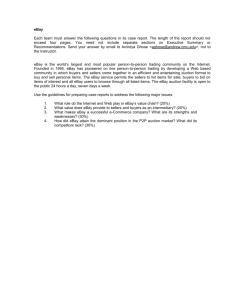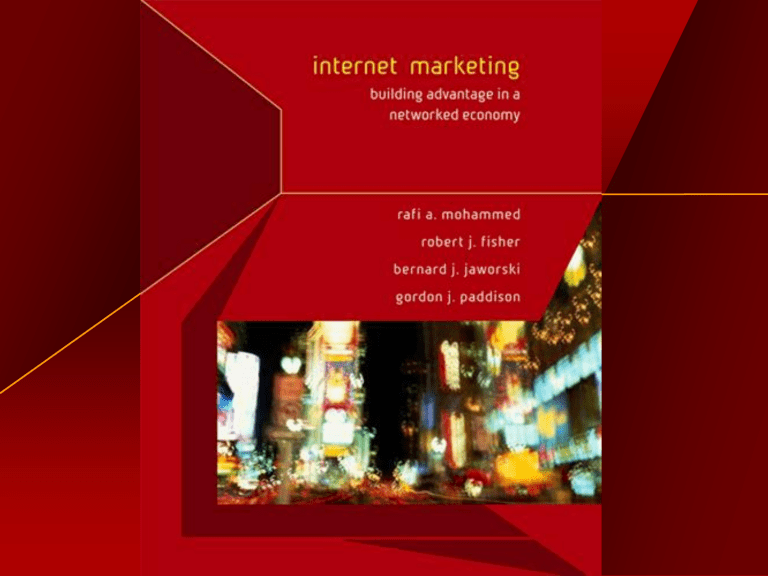
chapter
2
Framing the Market Opportunity
McGraw-Hill/Irwin
© 2004 The McGraw-Hill Companies, Inc., All Rights Reserved.
Framing the Market Opportunity —
Today’s Objectives
Objectives will be to:
Introduce the framework for market opportunity analysis
Examine three basic “value-types”
Discuss the identification of unmet and under-served needs
Explore how customers are segmented and targeted
Examine the role of resources in evaluating market opportunities
Discuss how to assess the attractiveness of a market opportunity
Examine eBay’s market opportunity
Chapter 2: Framing the Market
Opportunity
Market Opportunity Analytic Framework
Three Basic “Value Types”
Use of the Customer Decision Process to Identify Unmet and Underserved
Needs
Segmentation and Targeting
The Role of Resources in Evaluating Market Opportunity
Assessing the Attractiveness of a Market Opportunity
EBay’s Market Opportunity
Conclusion
Chapter 2: Framing the Market
Opportunity
Market Opportunity Analytic Framework
Three Basic “Value Types”
Use of the Customer Decision Process to Identify Unmet and Underserved
Needs
Segmentation and Targeting
The Role of Resources in Evaluating Market Opportunity
Assessing the Attractiveness of a Market Opportunity
EBay’s Market Opportunity
Conclusion
Framework for Market Opportunity
Seed Opportunity in Existing New Value
System
Identify Unmet and Underserved Need(s)
Identify Target Segment(s)
Declare Company’s Resource-Based
Opportunity for Advantage
Assess Competitive, Technical, and
Financial Opportunity Attractiveness
Make “Go / No Go” Assessment
Influenced by the New
Economy
• Competition occurs across
industries rather than within
industries
• Competitive behavior occurs
at unprecedented speed
• Competition occurs between
alliances of companies rather
than between individual
companies
• Easier to influence customer
behavior because still in early
stages of being defined
• Industry value chains are
being reconfigured
Exhibit 2.1: Framework for Market
Opportunity
Opportunity Analysis Steps
Benefit of Step
Step 1: Investigate opportunity in an
existing or new value system
Identifies previously unexploited areas of
potential market value for further analysis
Step 2: Identify unmet or underserved
needs
Uncovers customers decision process and
“opportunity nucleus” that a new offering
could address
Step 3: Determine target customer
segments
Allows a company to craft an offering that
will appeal to the target customers
Step 4: Assess resource requirements to
deliver the offering
Identifies existing resource strengths and
weaknesses needing to be addressed
internally or with partners to bring offering
to market
Step 5: Assess competitive, technological,
and financial attractiveness of opportunity
Determines the character and magnitude
of the opportunity; establishes barriers to
entry and potential rewards
Step 6: Conduct go/no-go assessment
Determines whether the opportunity is
attractive enough to pursue
Chapter 2: Framing the Market
Opportunity
Market Opportunity Analytic Framework
Three Basic “Value Types”
Use of the Customer Decision Process to Identify Unmet and Underserved
Needs
Segmentation and Targeting
The Role of Resources in Evaluating Market Opportunity
Assessing the Attractiveness of a Market Opportunity
EBay’s Market Opportunity
Conclusion
Exhibit 2.2: Three Types of Basic
Value
Trapped Value
More Efficient
Markets
More Efficient Value
Systems
New-to-the-World Value
Disrupt Pricing
Customize Offerings
Ease Access
Build Community
Radically
Extend Reach
Introduce New
Functionality or Experience
Hybrid Value
Exploring Basic Value
New-to-the-World Value
Trapped Value
Customizing offerings allows
customers to add and remove
features
More efficient markets lower
search and transaction costs
• Bizbuyer.com
• Yahoo
• Lending Tree Inc.
• Quicken.com
• OffRoad Capital Corp.
Build communities to leverage
customers’ participation
More efficient value systems
compress or eliminate steps in
an existing value system
• Zeal.com
• Amazon.com
Hybrid Value
Disrupt pricing and change
pricing-power relationships
• MySimon.com
Enable ease of access and
help customers find products
• Abebooks.com
Extend reach and welcome
distant customers
• Distance education
Introduce new functionality to
transform all or part of an
industry value chain
• e-books
• Internet telephony
Chapter 2: Framing the Market
Opportunity
Market Opportunity Analytic Framework
Three Basic “Value Types”
Use of the Customer Decision Process to Identify Unmet and
Underserved Needs
Segmentation and Targeting
The Role of Resources in Evaluating Market Opportunity
Assessing the Attractiveness of a Market Opportunity
EBay’s Market Opportunity
Conclusion
Customer Decision Process
A framework to look systematically for unmet or underserved needs
Prepurchase
Origination
What prompts the customer to action?
Information
Gathering
What factors influence the customer’s decision?
Evaluation
What attributes of the product
does the customer consider?
Purchase
Purchase
Decision
What options does the customer identify?
What decision(s) does he make?
Postpurchase
Postpurchase
Evaluation and
Behavior
What does the customer do about his decision?
Because value
creation is based
on understanding
and meeting
customer needs.
Exhibit 2.3: Decision for Purchasing a
Camera
Personal use
Origination
Prepurchase
Information
Gathering
Evaluation
Purchase
Type
(digital/film)
Features
Brand/
manufacturer
Cost
Complexity
Usage
occasions
Reviews
Past
Experiences
Budget
constraints
Film
Digital
Instant
Body Type
Lens
Purchase
Decision
35mm
Postpurchase
Gift
Postpurchase
Evaluation and
Behavior
APS
Print quality
Basic
Fully
loaded
Throwaway
Reliability
Standard
SLR
Learning
curve/
ease of use
Likelihood of repeat
purchase or
recommendation
Point &
shoot
Zoom
Range of
accessories
Fixed
Vacation Travel Destination Decision
Event
Break
Origination
Holiday
Prepurchase
Information
Gathering
Number and
Relationship of
Travelers
Honeymoon
Reunion
Duration and
Distance
Budget
Travel Agent
Activities
Weather
Past
Experiences
Travel Guides
Evaluation
Books
Brochures
Chat
rooms
Vacation
Package
Purchase
Purchase
Decision
World Tour
Comfort
Postpurchase
Independently
Planned
Small-Town
Discovery
Cruise
Style
Beach Escape
Photos
Postpurchase
Evaluation and
Behavior
Likelihood of Repeat
or Referral
Outdoor
Adventure
Degree of
Memorability
Chapter 2: Framing the Market
Opportunity
Market Opportunity Analytic Framework
Three Basic “Value Types”
Use of the Customer Decision Process to Identify Unmet and Underserved
Needs
Segmentation and Targeting
The Role of Resources in Evaluating Market Opportunity
Assessing the Attractiveness of a Market Opportunity
EBay’s Market Opportunity
Conclusion
Exhibit 2.4: Segmentation
Approaches
Segmentation Type
Description
Examples of Variables
Geographics
Divides market into geographical
units
Country, region, city
Demographics
Divides market on the basis of
demographic values
Age, gender, income,
education
Firmographics
Divides market on the basis of
company-specific variables
Number of employees,
company size
Behavioral
Occasion (Situational)
Divides market based on how
customers actually buy and use
the product
Divides market based on the
situation that leads to a product
need, purchase or use
Website loyalty, prior
purchases
Routine occasion, special
occasion, part of day
Psychographics
Divides market based on lifestyle
and/or personality
Personality (laid-back, type
A), lifestyle
Benefits
Divides market based on benefits
or qualities sought from the
product
Convenience, economy,
quality
Effective Segmentation
Requirements
Customers must demonstrate needs, aspirations or behavioral patterns that are similar
within a segment and different across segments
– A distinction between a price-sensitive and a quality-seeking segment is meaningful,
since the two segments demonstrate distinguishable sets of needs
A company must be able to reach customers within each segment through effective and
targeted marketing programs
– A customer segment consisting of customers with blue eyes is not actionable, since
it is very hard to identify and reach only customers with blue eyes
Segments must be large and profitable enough to make the investment in serving them
worthwhile
– MyCFO.com is targeted toward high-net-worth individuals, helping them manage
their portfolios; even though the number of those individuals is small, the dollar
amount managed is sizeable, thus constituting a substantial segment
Key characteristics of the segments (e.g., size and spending patterns) must be easy to
measure
Meaningful
Actionable
Substantial
Measurable
Source: Philip Kotler, Marketing Management (1997), p. 269
Exhibit 2.6: Consumer Digital
Camera Purchasing Segmentation
Consumer E-Books Purchasing
Segmentation
Purchase
Occasion
Self-Consumption
Business Education
Gift
Leisure
Leisure
Reader
Hobby or
Special Collection
Interest
Institutional
Business
Corporate Education
By
Request
39
College
Education
Hobby or Special
Interest
40+
In-Depth Topical
Insights and
Discussion
Reference and
Research Materials
Compendium
by Topic
39
Moderate
Education
Required
Reading
For Display
40+
39
Limited
Education
Entertainment
How-To
Information
40+
How-To
Information
Advice
and
Recommendations
Number of E-Books Purchased
Purchase
Occasion
Self-Consumption
Business Education
Gift
Leisure
Leisure
Reader
Hobby or
Special Collection
Interest
Institutional
Business
Corporate Education
By
Request
39
College
Education
Hobby or Special
Interest
40+
In-Depth Topical
Insights and
Discussion
Reference and
Research Materials
Compendium
by Topic
39
Moderate
Education
Required
Reading
For Display
40+
39
Limited
Education
Entertainment
How-To
Information
40+
High
Moderate
Low
How-To
Information
Advice
and
Recommendations
Ideal E-Book Delivery Mechanisms
Purchase
Occasion
Self-Consumption
Business Education
Gift
Leisure
Leisure
Reader
Hobby or
Special Collection
Interest
Institutional
Business
Corporate Education
By
Request
39
College
Education
Hobby or Special
Interest
40+
In-Depth Topical
Insights and
Discussion
Reference and
Research Materials
Compendium
by Topic
39
Moderate
Education
Required
Reading
For Display
40+
39
Limited
Education
Entertainment
How-To
Information
How-To
Information
40+
New Economy
Either
Traditional
Advice
and
Recommendations
Amazon.com Homepage for Two
Different Customers
Chapter 2: Framing the Market
Opportunity
Market Opportunity Analytic Framework
Three Basic “Value Types”
Use of the Customer Decision Process to Identify Unmet and Underserved
Needs
Segmentation and Targeting
The Role of Resources in Evaluating Market Opportunity
Assessing the Attractiveness of a Market Opportunity
EBay’s Market Opportunity
Conclusion
Specifying a Resource System
Identify core benefits in the value proposition or cluster
Identify capabilities that relate to each benefit
Link resources to each capability
Identify to what extent the firm can deliver each capability
Identify partners who can complete capabilities
Assessing the Quality of a Resource
System
Good resource systems provide benefits, capabilities and activities
that are different from those of competitors
Good resource systems have links between capabilities and
benefits, among capabilities, among resources, and between
virtual-world and physical-world business systems
Good resource systems are difficult for competitors to replicate
Uniqueness
Links
Sustainability
Source: Philip Kotler, Marketing Management (1997), p. 269
Chapter 2: Framing the Market
Opportunity
Market Opportunity Analytic Framework
Three Basic “Value Types”
Use of the Customer Decision Process to Identify Unmet and Underserved
Needs
Segmentation and Targeting
The Role of Resources in Evaluating Market Opportunity
Assessing the Attractiveness of a Market Opportunity
EBay’s Market Opportunity
Conclusion
Exhibit 2.8: Competitor Profiling —
Eastman Kodak
Exhibit 2.12: Kodak’s Overall
Opportunity Assessment
Positive
Factor
Neutral
Factor
Negative
Factor
Competitive
Vulnerability
Technical
Vulnerability
Magnitude
of Unmet
Need
Interaction
Between
Segments
Likely Rate
of Growth
Technological
Vulnerability
Market
Size
Level of
Profitability
Chapter 2: Framing the Market
Opportunity
Market Opportunity Analytic Framework
Three Basic “Value Types”
Use of the Customer Decision Process to Identify Unmet and Underserved
Needs
Segmentation and Targeting
The Role of Resources in Evaluating Market Opportunity
Assessing the Attractiveness of a Market Opportunity
EBay’s Market Opportunity
Conclusion
Exhibit 2.13: EBay’s Financial Growth
800
700
Net Revenue
748
Gross Profit
Millions of dollars
614
600
500
431
400
335
300
224
200
100
167
86
41
70
32
0
1997
1998
1999
2000
2001
Exhibit 2.14: Market Share — EBay
Yahoo
3%
Amazon
2%
Egghead
5%
uBid
17%
eBay
73%
Exhibit 2.15: EBay — Defining the
Value System
Value Type
Trapped
Hybrid
How
Create
more efficient markets
Create
more efficient value systems
Disrupt
market pricing
Enable
ease of access
Radically
extend reach
Customize
New
Enable
offerings
community building
Introduce
new functionality or experience
Extent
Exhibit 2.16: EBay — Unmet and
Underserved Needs
Auction House /
Dealer
Buyer
Realize he or she
would like to sell
something
Like to browse or have
a specific interest or
need
Research the value of
the item and a possible
channel for exchange
Research venues /
channels for
procurement
Choose exchange
agent and negotiate
terms
Establish and agree to
selling / buying process
Deliver merchandise
Set auction schedule
and choose venue
Determine appropriate
schedules and
locations
Hold auction
Attend auction
Choose procurement
channel
Notification of when specific items are being sold
Easy channel / venue access
Objective listing agent
Purchase
Pre-Purchase
Seller
Passive search and decision process
Easy listing process and objectives
Ability to list modestly priced items
Improved availability and access
Simplified shipping; elimination of two-stage process
Conduct preliminary
research on items
Time to conduct due diligence research on items
Bid
Time to think about purchase
Post-Purchase
Win?
Receive payment
Receive payment
Pay
Ease of payment
Take commission
Receive merchandise
Reasonable agent fees
Minimized time lag between merchandise surrender and
compensation
Pass a percentage of
proceeds to seller
Exhibit 2.17: Potential EBay
Customers
Promotional
Behavior
User
Demographics
History of Responding to Promotions
Very High
High
Moderate
Limited
None
39
High
Income
40+
Active Deal-Makers with
Means
39
Active
Frugal
Collectors
Passive Collectors
Ease
Convenience
Moderate
Income
40+
Active Frugal Collectors
39
Limited
Income
Price-Sensitive
40+
Limited Accessibility or
Options
Exhibit 2.18: EBay Overall
Opportunity Assessment
Positive
Factor
Neutral
Factor
Negative
Factor
Competitive
Vulnerability
Magnitude
of Unmet
Need
Interaction
Between
Segments
Likely Rate
of Growth
Technological
Vulnerability
Market
Size
Level of
Profitability
Chapter 2: Framing the Market
Opportunity
Market Opportunity Analytic Framework
Three Basic “Value Types”
Use of the Customer Decision Process to Identify Unmet and Underserved
Needs
Segmentation and Targeting
The Role of Resources in Evaluating Market Opportunity
Assessing the Attractiveness of a Market Opportunity
EBay’s Market Opportunity
Conclusion
Framing the Market Opportunity —
Conclusion
A firm needs to follow a rigorous approach to correctly isolate market
opportunities — the market opportunity analysis framework is a sixstage process that addresses this need
The six stages of the framework are: 1) seed opportunity in an
existing new value system, 2) identify unmet and underserved
need(s), 3) identify and choose target segments, 4) declare the
company’s resource-based opportunity for advantage, 5) assess
competitive, technological and financial opportunity attractiveness and
6) conduct a “go/no-go” assessment
In assessing the attractiveness of an opportunity, four dimensions
should also be considered: 1) competitive intensity, 2) customer
dynamics (e.g., unmet needs, likely rate of growth, etc.), 3)
technological vulnerability and 4) microeconomics (industry size and
profitability)


